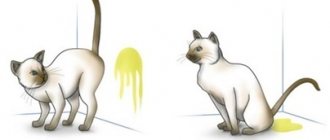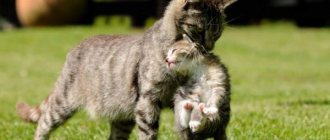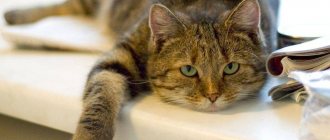The cat is wildly afraid of strangers
Hello!
The cat is approximately 7 months old (neutered a week ago, vaccinated, healthy). Two months ago she was picked up on the street. Since then, he only trusts the girl with whom he lives. He hides in front of strangers, shakes, and is wildly afraid. As soon as he realizes that a stranger has come in, the cat changes before his eyes and disappears. At the same time, he is an ideal cat with his owner. Affectionate, sociable, playful. This behavior problem has remained unchanged for these two months.
Some cats cannot stand strangers in the house. One of the reasons for this behavior is the lack of communication with people at an early age: sometimes, for a cat to hide from guests for the rest of its life, it only takes one case when a guest was too noisy or treated the kitten poorly.
A particularly nervous and fearful cat can be given a sedative - special drops, but you should not give such a remedy all the time. A sedative is just a small help that helps to slightly speed up the process of getting used to strangers. In any case, with or without drops, frequent meetings with people should help the cat understand that the arrival of guests does not threaten it in any way. It is very important that the cat, without running away, learns to allow strangers at a fairly close distance.
One of the ways to accustom a cat to guests is to prevent it from running away and hiding. To do this, put a harness on it or put it in a carrier for a while. Moreover, it is desirable that the cage is located in the same room as the guests, who need to be warned so that they behave calmly, do not shout or raise their voices. At first, your family members can play the role of invitees. Of course, at first the doorbell will alarm the pet, but the cat will no longer be able to escape from the carrier and as soon as it sees its friends, it will quickly calm down. If you do this constantly, the cat will very quickly get used to the idea that the doorbell does not pose a threat. Over time, you will be able to ask "real" guests to enter the room with one of the family members and sit next to the cage. It is only important that the training is regular. In this case, the cat carrier will become a shelter.
As soon as the cat, being in its house, gets used to guests, you need to gradually accustom it to closer contact with them. Let guests sit as close to the pet's cage as possible, but do not lean over. In this case, you can offer the cat some kind of treat: food strengthens relationships much faster than affectionate conversations. Most likely, the cat will refuse the treat at first, but sooner or later everything will work out. The main thing is to be patient and attentive.
Designate the cat's room
Sometimes having a whole house to explore is too much for a cat, so you may have to temporarily narrow the space.
Remember that cats are territorial, so having a lot of space to “watch” can be exhausting. Creating a room just for your cat may be a good approach. This creates a home within a home with all the amenities a kitten needs, including food, bedding, bed and toys. A safe haven can be created in any spare room that is not actively used.
You can keep the door closed at first until the kitten adjusts to the environment. After a while, open the door and let him explore the rest of the house at his own pace.
This could be at night when everyone is sleeping, and that's okay. You can also leave a bowl of treats in another room to encourage your cat to come out of hiding more often.
Why is a cat afraid of strangers?
A famous English writer once said: “A real cat strives to live its life peacefully, so that people interfere with it as little as possible. In this way, real cats are very similar to real people.” Indeed, most cats, despite their love for their owner, behave somewhat distantly, reacting sharply to the invasion of the personal space of strangers. Moreover, some individuals are very afraid of strangers and, when they appear, rush to sneak away. What could be the reason for this behavior and can it be corrected?
How does prolonged stress affect a kitten?
Constant exposure to stress negatively affects the kitten:
· reduces immunity;
Causes hormonal imbalance;
· leads to obesity;
· causes diabetes, alopecia, mental disorders;
· Causes urinary tract diseases;
· disrupts digestive processes;
· leads to behavioral disturbances, fear and rejection of the owner/other family members/pets.
Main causes of fear
The character of cats is not as flexible as, for example, dogs. In addition, these animals are not so successful in training, and few people manage to teach them complex tricks. Experienced cat owners believe that if a pet experiences fear of humans, this can lead to serious consequences. There is a completely logical explanation for this - even small mustachioed striped animals are, in fact, predators, and at the genetic level they are accustomed to attacking a frightening subject, rather than fleeing.
Among the main reasons for cats' fear of people are:
- Human rudeness towards animals, physical torture, deliberate intimidation.
- Previous negative experience of communication between an animal and people, because we must not forget about the excellent memory of cats.
- Infringement of rights to territory.
- Lack of self-confidence.
- Incomplete or impaired socialization.
Excessive fearfulness of a pet usually worries the owner, but most conditions can be corrected. The main thing is to find out why the animal is afraid of people.
The cat doesn't let you sleep at night: what to do and how to deal with it
If a cat often does not sleep at night and meows on purpose, wakes up the owner, pushes objects, then most often this is due to lack of attention
The pet needs communication, he wants the owner to pay attention to him and make contact. The owner of the animal has a job, acquaintances, friends, recreation, hobbies, but the pet only has an apartment and the person who tamed it
Therefore, of course, the animal wants attention from those closest to it. If you don’t always have enough time to play, then you can talk to the animal after returning from work, or pet it and allow it to be nearby. It is necessary to take care of the cat, comb it, try to really contact him every day and let him know that he is not alone. You need to try to pay enough attention, then the pet will feel an emotional connection with the owner, and he will not be so lonely.
Wild and domesticated cats
Usually, when talking about wild cats, we mean animals born on the street. The four-legged animals stay in the nest for up to 1.5–2 months and do not see people or other animals. Afterwards they explore the world under the strict control of their mother. Naturally, the “two-legged giant” seems like a threat to the little kitten. The reaction is quite predictable - run for cover, and if caught, then scratch, hiss, bite and call for the mother.
Important! Even a 1-2 month old wild kitten is capable of causing serious scratches and bites, and if the mother comes to the cry of the baby, you will have a very hard time. Not only will the mother cat attack, but she will also chase you until you leave her territory.
Tamed cats are animals that lived in human company for some time, but suddenly began to be afraid of people. In addition to bites and scratches, you can receive gifts from a frightened animal in the form of piles and puddles, torn wallpaper or torn curtains. It is more difficult to correct the behavior of a domestic cat than a wild one. A kitten on the street can be accustomed to itself gradually, because the main reason for fear is mistrust. The domestic cat already knows people, but harbors a grudge (fear).
Important! Overly aggressive behavior also indicates fear, but the reason may not lie in fear of people.
Dangerous consequences
Prolonged stress disrupts the functionality of all vital organs. The very first blow falls on the immune system.
Physiological
As a result of decreased immunity in the “mustache,” chronic diseases worsen and the risk of infection with bacteria and viruses increases. Most often, complications are observed in the following organs and systems:
- genitourinary (cystitis);
- Gastrointestinal tract (chronic constipation, intestinal obstruction);
- cardiovascular system (impaired blood supply to the heart).
Nervous tension also affects your appearance. The pet's fur becomes dull and falls out, dandruff appears and anorexia develops.
Psychological
Psychological disorders develop in parallel with physiological ones. They are reflected in the behavior of the mustache. He becomes more fearful and aggressive. Under the influence of a certain trigger (an explosion of a firecracker, the sight of a syringe, the noise of a drill), the animal can attack the owner and cause severe injuries.
Another possible consequence is obsessive-compulsive disorder. This pathology manifests itself in the repetition of obsessive actions: licking fur until there are bald spots, scratching until it bleeds, walking in circles or chasing the tail. The trigger in this case is also a trigger, but with a prolonged course the strange behavior becomes fixed.
The main reasons for cats’ fear of people and methods for correcting behavior
What to do if your cat is afraid of people and even you? What if an animal attacks your children or guests? Does it bother other animals in the house? First, you need to figure out what causes your pet’s stress. The first thing to exclude:
Rough behavior, physical punishment, intentional intimidation
Do you scream, spank, swing or stomp on your pet? This is rude, aggressive and threatening behavior, if after such gestures the cat begins to be afraid and attack you - do not be surprised, you deserve it! If you want to correct the situation, start with yourself; it is not your pet’s fault that he is forced to defend himself and fear for his life.
Negative experience
Usually, in this case, cats are afraid of certain people, for example, veterinarians after undergoing surgery. Also included in this category are animals that have experienced rough treatment or bullying by their former owners. Animals that have experienced the horrors of existence in municipal shelters are usually also afraid of people who resemble former caretakers.
Helping your cat cope with stress
Cats have a hard time with changing their environment; it is stressful for them. What to do if you can’t avoid a trip to the country, a trip to the veterinarian or hairdresser?
Two necessary conditions for the trouble-free movement of a cat are a calm owner and a comfortable carrier, which should become a second home for the animal. You cannot carry the animal in your arms.
Before traveling, prepare a mobile shelter for your cat - a comfortable carrier with hard walls, soft bedding and ventilation. For sound insulation and warmth, the carrier is wrapped with soft cloth on top. The cat should perceive the mobile house as a shelter where your pet can hide, say, after a doctor’s examination and calm down.
Required conditions after stress - peace and quiet
Habit plays an important role. If you plan to often take your cat with you on trips, you need to gradually accustom it to this from childhood. A pet that regularly travels in its portable home will not create problems during its next voyage.
Medicinal methods
In order to prepare the cat for stress, which cannot be avoided, special medications based on herbal ingredients are used. For example, Fitex contains hops, motherwort, valerian, and Baikal skullcap. In addition to these herbs, Stop-Stress contains phenibut. The drug Kot Bayun is available in the form of infusion and tablets. It includes extracts from a dozen medicinal plants.
To overcome stressful situations, calming cat food containing herbal sedatives and special collars with pheromones are also produced.
A calming collar with pheromones will help the animal cope with a stressful situation
Table: Calming products for cats
| A drug | Active substance | Release forms | Dosage | Effect | Price |
| Stop stress | Active ingredients: phenibut (aminophenylbutyric acid) + extracts of medicinal plants (catmint, motherwort, hops, Baikal skullcap). | Drops and tablets | 1 drop per kg of animal body weight twice a day; or 0.25 tablets with a weight up to 5 kg, 0.5 - with a weight from 5 to 10 kg; for body weight more than 10 kg, give a whole tablet. | Long lasting calming effect | 145 rub. |
| Fitex | Plant origin. The composition of the drug includes the following extracts: - thick extract of valerian officinalis (valeriana officinalis) - dry extract of motherwort (leonurus quinquelobatus gilib) - dry extract of common hop (humulus lupulus) - dry extract of Baikal skullcap (scutellaria baicalensis georgi) 1 ml The drug contains 100 mg of the sum of dry and thick extracts. Does not contain sugar or ethyl alcohol. | Drops | 3–5 drops three times a day | Mild sedation | 130 rub. |
| cat Baiyun | Only plant components, contains aqueous extracts from plant materials: oregano herb - 0.45%, sweet clover herb - 0.23%, rhizomes with valerian roots - 0.23% and phytocomplex - 1.45%, containing extracts of flowers and fruits hawthorn, hop cones, motherwort herb, peppermint leaves, ivy grass, catnip herb, lemon balm herb, meadowsweet flowers, St. John's wort herb, thyme herb, cudweed herb, hillwort herb, nettle leaves, roots, rhizomes and herb of evasive peony , and as an auxiliary substance - distilled water - up to 100%. | Infusion and tablets | A single dose for infusion is 2 ml (half a teaspoon); for tablets - 2 pieces. Frequency of administration: 3–4 times a day. Tablets are used starting from the age of 10 months of the animal. | Long-term sedative effect: stabilization of the animal’s condition for 5–7 days | Drops - 132 rub. per package. Tablets - 115 rub. |
| Xylazine | The synthetic compound is a derivative of thiazine Xyl as an active ingredient in 1 ml contains 20 mg of xylazine hydrochloride, as well as excipients: sodium metabisulfite - 1 mg, citric acid - 10 mg, benzyl alcohol - 0.01 ml, sodium hydroxide (for pH correction = 5.0) and water for injection - up to 1 ml. | Injection | According to the instructions for use, 0.25 ml per 100 kg of weight is used for sedation; for sedation accompanied by muscle hypotonicity and analgesic effect - 0.5 ml; for immobilization and pain relief 1.0 ml; for long-term surgical intervention 1.5 ml (this dose is used only for adult animals). | Calming, analgesic, muscle relaxant | 630 rub. |
Photo gallery: sedative medications
Fitex drops for cats calm and heal Xylazine has a calming and analgesic effect Drops for cats Stop Stress have a long-lasting calming effect Kot Bayun - a dietary supplement for a calm life for cats
No one is immune from stress and fear, not even cats. Each domestic cat has a unique character and temperament. No one knows how your pet will behave in an unusual situation. Only love, care and the right reaction will help owners of tailed pets find the right approach to their animal and help them cope with emotional turmoil.











